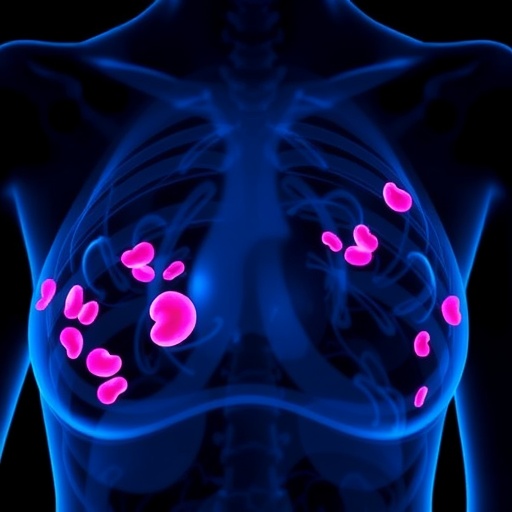In the realm of breast cancer research, triple-negative breast cancer (TNBC) remains a daunting challenge due to its aggressive progression and limited therapeutic options. Characterized by the absence of estrogen receptor (ER), progesterone receptor (PR), and human epidermal growth factor receptor 2 (HER2), TNBC defies traditional hormone-based and targeted treatments commonly employed in other breast cancer subtypes. Amid this ongoing struggle, a groundbreaking study from the National Cancer Institute, Cairo University, delves deep into the role of trophoblast cell-surface antigen 2 (TROP-2), illuminating new pathways for both prognosis and therapeutic innovation in TNBC.
TROP-2 is a transmembrane glycoprotein increasingly recognized for its overexpression in several aggressive malignancies, including pancreatic, gastric, and ovarian cancers. Its function as a prognostic biomarker and a therapeutic target has garnered considerable attention, especially given its potential in facilitating targeted precision therapies. The study spearheaded by Ebrahim et al. provides compelling evidence correlating TROP-2 expression levels with clinicopathological features and survival outcomes in patients diagnosed with TNBC, marking a significant stride in cancer biomarker research.
The researchers conducted a retrospective analysis incorporating tumor samples from 80 TNBC patients treated between January 2016 and December 2019. These samples, preserved in formalin-fixed, paraffin-embedded (FFPE) tissues, were examined using advanced immunohistochemical techniques to detect and quantify TROP-2 expression. This approach enabled a robust evaluation of protein localization and intensity within tumor cells, thereby facilitating precise correlation with clinical data including tumor size, nodal involvement, and patient survival metrics.
Intriguingly, the study revealed that a remarkable 78% of TNBC cases exhibited high TROP-2 expression, characterized by variability in staining intensity, percentage of positive cells, and overall H-score—a composite measure reflecting both these factors. This heterogeneity in expression underscores the complex biological landscape of TNBC and highlights TROP-2 as a potential indicator of tumor aggressiveness. The strong association between heightened TROP-2 levels and larger tumor dimensions, alongside more advanced nodal status, suggests that this glycoprotein plays a pivotal role in tumor progression and metastatic potential.
Beyond mere association, the statistical analyses elucidated the prognostic value of TROP-2 in TNBC. Both overall survival (OS) and disease-free survival (DFS) were significantly compromised in patients exhibiting elevated TROP-2 intensity and H-scores. Specifically, p-values of 0.003 and 0.007 for OS, and 0.002 for DFS, firmly establish the strength of these correlations. Such findings empower clinicians with a vital biomarker that not only characterizes tumor biology but also anticipates patient outcomes with considerable accuracy.
Further depth was achieved through multivariate analysis, confirming that TROP-2 intensity, percentage expression, and comprehensive H-score independently predict both OS and DFS. This statistical rigor substantiates TROP-2’s utility beyond conventional clinicopathological parameters, positioning it as a standalone variable in prognostic modeling for TNBC. These insights open the door to more personalized treatment approaches, wherein TROP-2 expression profiling could guide therapeutic decisions and patient stratification.
The implications of these findings extend deeply into the therapeutic realm. With TROP-2 emerging as a driver of tumor aggressiveness and a significant prognosticator, the protein offers an enticing target for the development of novel therapies in TNBC. Current treatment regimens lack targeted options due to the tumor subtype’s receptor-negative status. By exploiting TROP-2 overexpression, researchers and pharmaceutical developers can pioneer antibody-drug conjugates or other molecular strategies to selectively attack malignant cells, potentially improving outcomes for this high-risk patient population.
This study also reflects broader advancements in precision oncology, emphasizing the shift from generalized treatment protocols to biomarker-driven interventions. Harnessing TROP-2 expression data could spur the introduction of companion diagnostics, thereby refining patient eligibility criteria for emerging targeted therapies. This stratification aligns with the overarching goal of maximizing therapeutic efficacy while minimizing unnecessary toxicity, thereby enhancing quality of life for TNBC patients.
Moreover, understanding TROP-2’s biological role enriches knowledge regarding cancer signaling pathways and cellular mechanisms underpinning malignancy. Its involvement in cell proliferation, adhesion, and migration provides a mechanistic rationale for its association with tumor aggressiveness. Continued research into these molecular pathways may reveal additional therapeutic avenues or combinatory treatment regimens, reinforcing TROP-2’s importance as not merely a biomarker but a functional player in tumor biology.
Clinical translation of these findings will require extensive validation in larger, diverse cohorts and prospective clinical trials. Integrating TROP-2 evaluation into routine diagnostic workflows presents logistical challenges but promises substantial clinical benefit. The study by Ebrahim et al. thus lays foundational groundwork that beckons further exploration and clinical application, signaling a hopeful horizon in TNBC management.
In essence, TROP-2 expression in triple-negative breast cancer stands at the intersection of prognosis and therapy, embodying the next wave of precision oncology innovations. It epitomizes a shift towards understanding tumor heterogeneity and deploying tailored interventions that can significantly alter disease trajectories. As research advances, targeting TROP-2 might revolutionize standard care paradigms, offering renewed hope against one of oncology’s most challenging adversaries.
The impact of this research resonates beyond TNBC, serving as a model for biomarker discovery and therapeutic exploitation in other malignancies marked by aggressive behavior and treatment resistance. The successful translation of TROP-2 targeted strategies could inform broader oncological applications, underscoring the value of integrative molecular research in revolutionizing cancer therapy on a global scale.
Taken together, the insights from the National Cancer Institute’s study affirm TROP-2’s multifaceted role, bridging the gap from biomarker identification to actionable targeted therapy. This approach exemplifies the dynamic evolution of cancer research, where molecular characterization directly informs clinical innovation, ultimately aiming to extend survival and enhance patient outcomes in triple-negative breast cancer.
Subject of Research: Investigation of Trophoblast Cell-Surface Antigen 2 (TROP-2) expression as a prognostic biomarker and therapeutic target in triple-negative breast cancer.
Article Title: From biomarker to targeted therapy: investigating trophoblast cell-surface antigen 2 expression in triple-negative breast cancer – insights from the national cancer institute.
Article References:
Ebrahim, N.A.A., Hussein, M.A., Sobeih, M.E. et al. From biomarker to targeted therapy: investigating trophoblast cell-surface antigen 2 expression in triple-negative breast cancer – insights from the national cancer institute. BMC Cancer 25, 1008 (2025). https://doi.org/10.1186/s12885-025-14402-7
Image Credits: Scienmag.com




